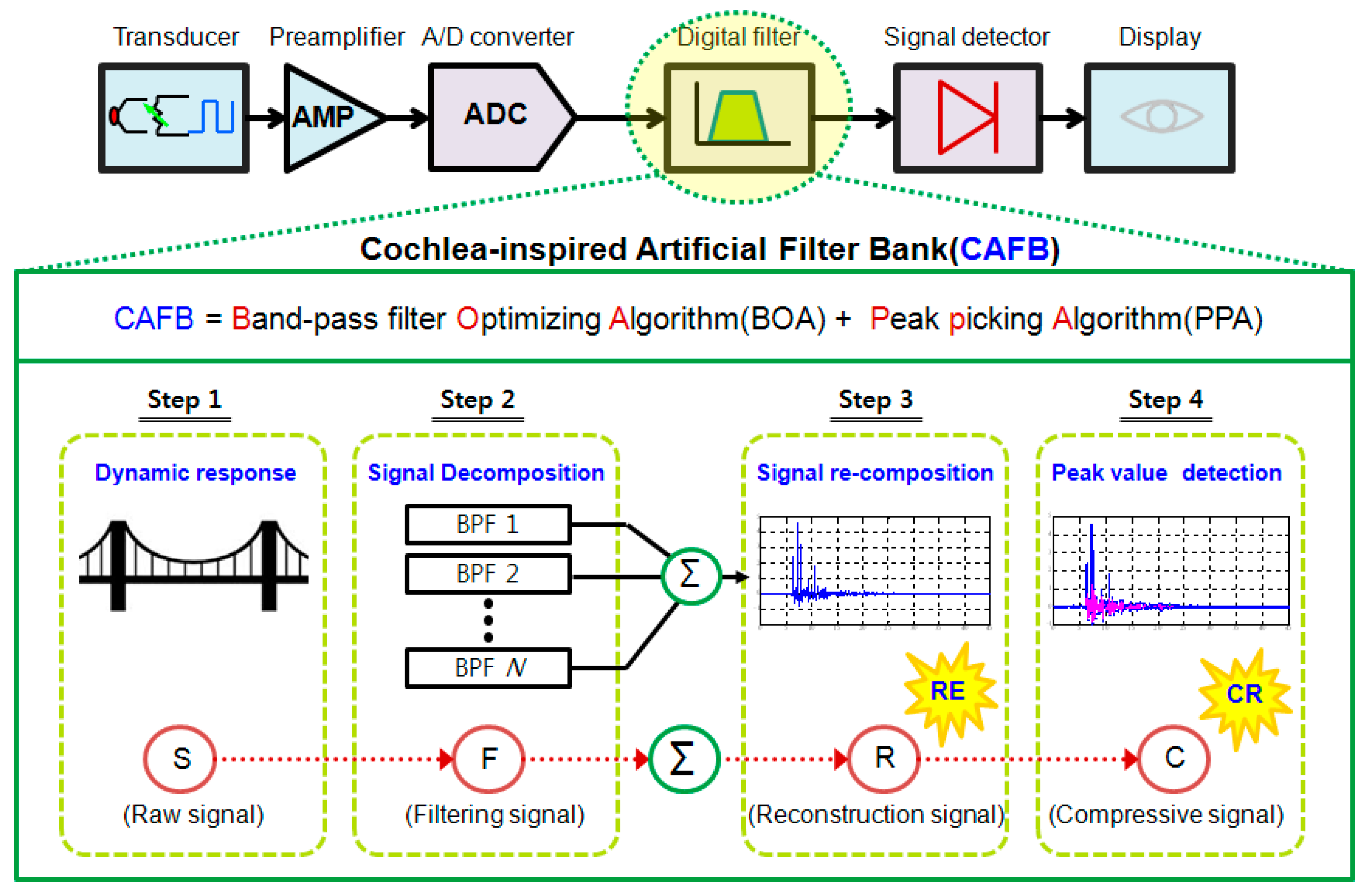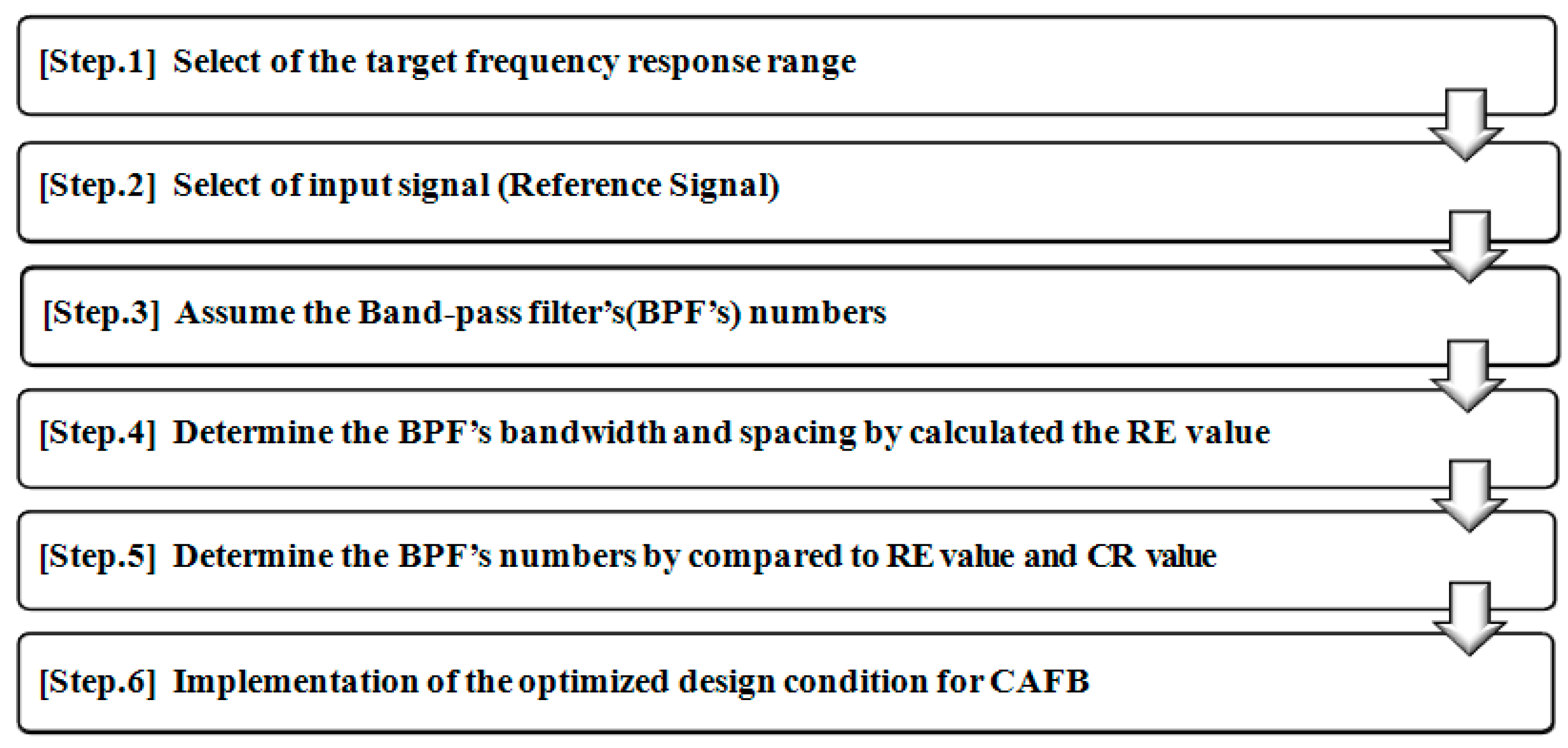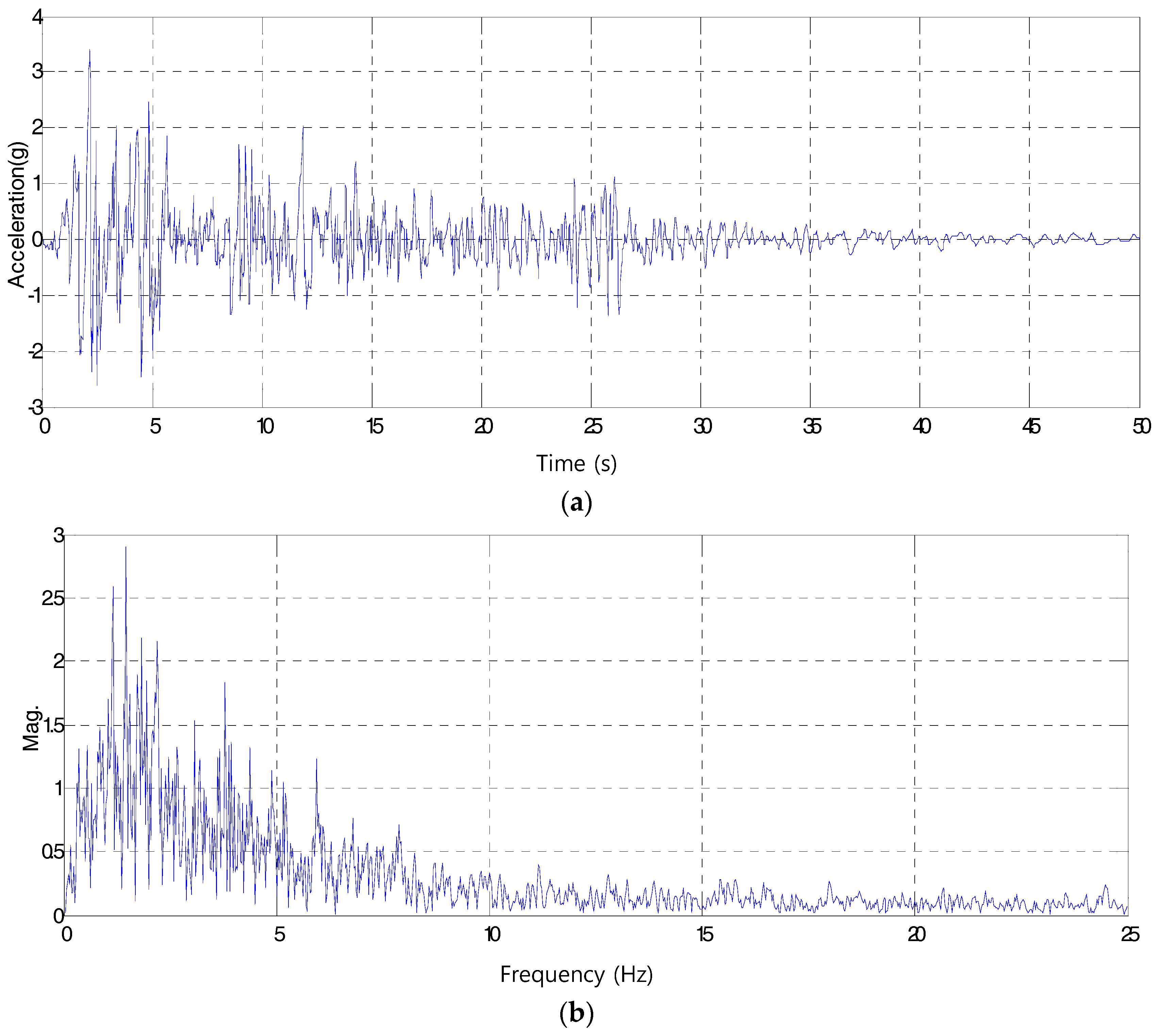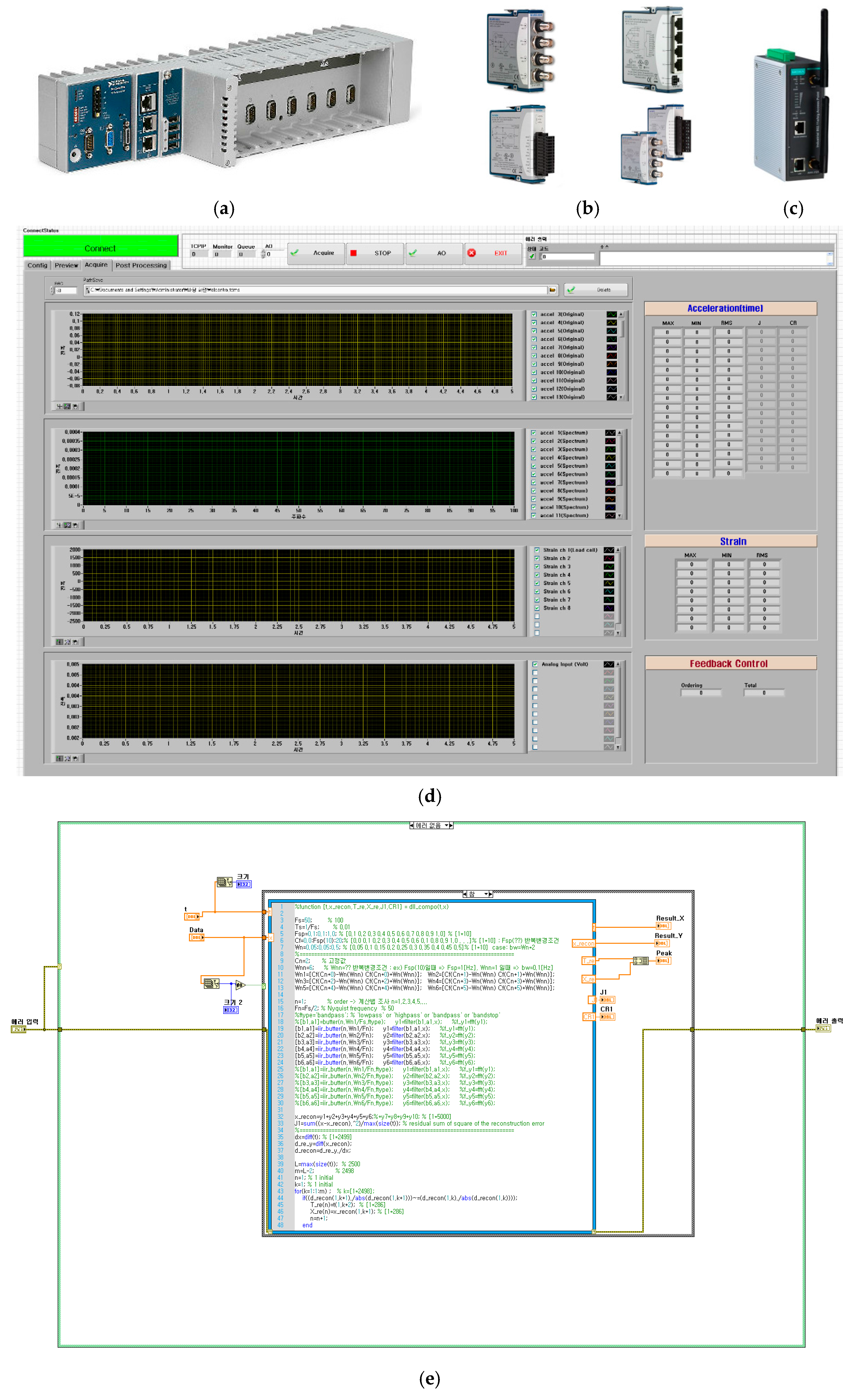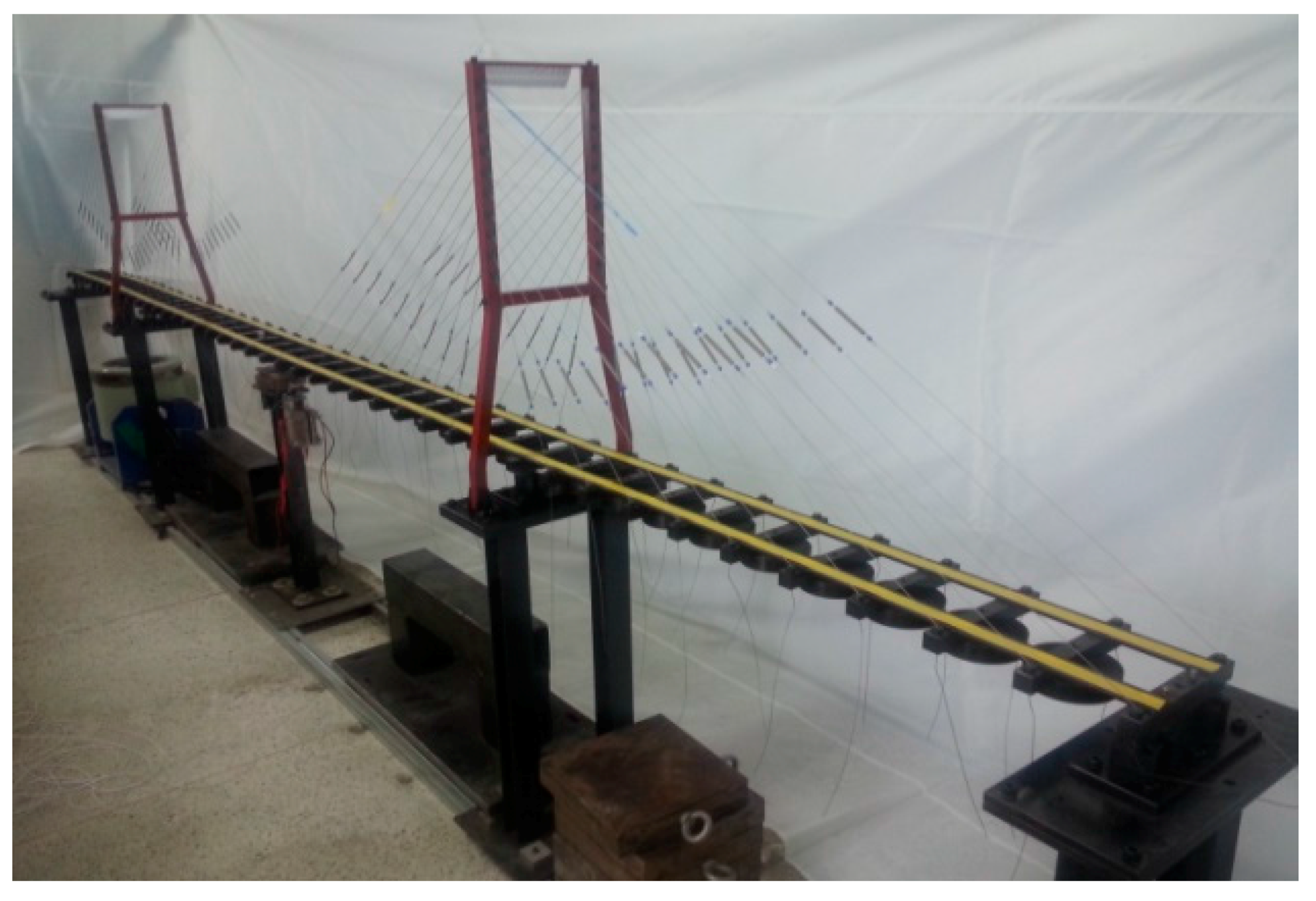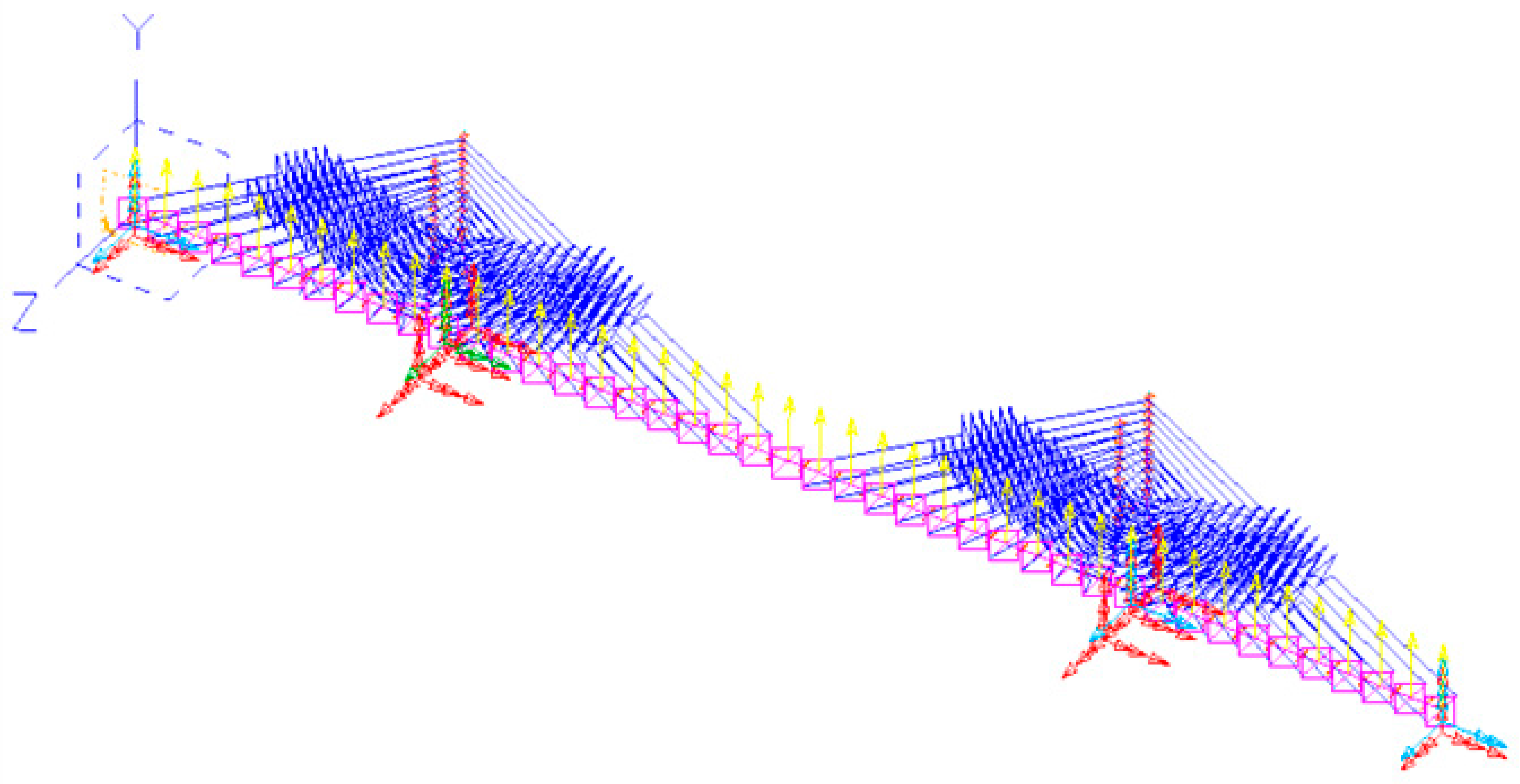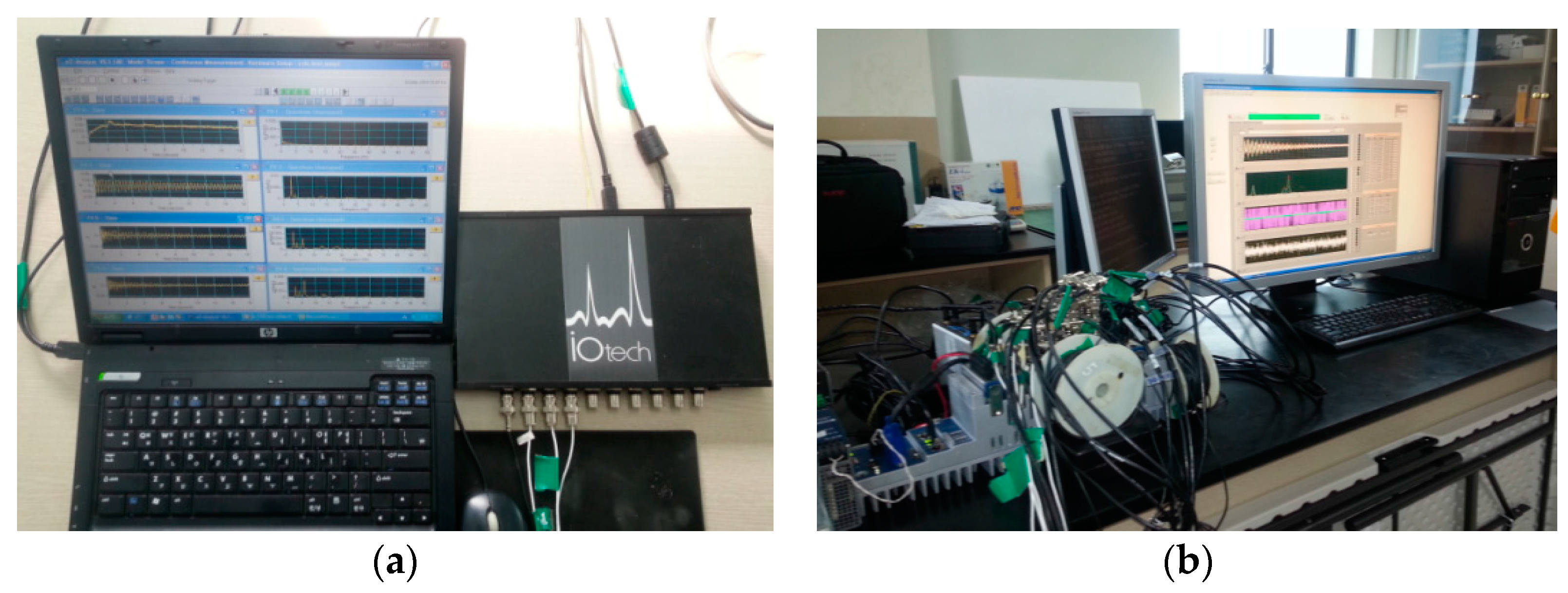2.1. Principle of the CAFB
A previous study has developed the CAFB using n number of band-pass filters to obtain and compress the dynamic response for structures which is required in SHM on civil structures. As shown in
Figure 1, CAFB is performed the signal processing (Input of signal (Step 1); Decomposition (Step 2); Reconstruction (Step 3); Compression (Step 4)) using a raw signal obtained from the structure.
As shown in
Figure 1, CAFB is using two kinds of algorithms; one is BOA (band-pass optimizing algorithm) to selectively obtain the interested frequency band, and the other is PPA (peak picking algorithm) to compress the selected signals.
First, the BOA was used to design multiple band-pass filters in parallel such that they could be suitably used to determine the target mode required to evaluate the dynamic behavior of the civil structure and additionally calculate the reconstruction signal by altering the design conditions, such as the number, bandwidth, and interval of the band-pass filters. Finally, the reconstruction signal was evaluated through a comparison with the raw data acquired from the target structure. To evaluate the reconstruction signal compared to the raw data, the reconstruction error (RE) is the comparative difference between the composition of filtered signals and the original (raw) signal as expressed in Equation (1) and
Figure 2. The RE defined in Equation (1) is represented by the relative difference of absolute values between the original and reconstruction signals. Here,
u(
t) is the raw data as a function of the response time,
y(
t) is the reconstruction signal as a function of the response time, and
T is the total length of the response time, i.e., the total length of the input signal. The closer to 0 the reconstruction error is, the better the reconstruction effect.
Next, a peak-picking algorithm (PPA) was developed for compression, which determines the peak value based on only the reconstruction signal determined through Equation (1). The PPA’s calculation process can be summarized as follows: First, the calculated reconstruction signal is read from the optimized filter bank. Second, the reconstruction signal is classified into three (3) data groups. Third, each group’s derived function is calculated based on three data points in each group. Fourth, peak values (time and measuring data) are derived by assessing the slope (sign) of each group’s derived function. In this study, a central difference method is used as a way to extract peak values while the PPA is calculating.
Figure 3 below reveals the central difference method’s conceptual diagram, and a derived function can be calculated through Equation (2):
Based on the size of the reconstruction data determined through Equation (1) above, the effects of data compression through PPA can be defined by comparing a relative data size with the extracted peak value. For this, this study defines the data CR (compressive ratio) as stated in Equation (3) below:
Here, is the number of the compressive signal and is the number of the reconstruction signal. The closer to 0 the compressive ratio is, the better the compression effect is. The compressed signal is transmitted to the host through the WSNs.
The reconstruction error (RE) shown in Equation (1) signifies an index for the precision of reconstruction signals which were first filtered through the CAFB. Especially, it is one of the optimization elements along with the CR in Equation (3) which is used to calculate the optimal conditions (number of band-pass filters, bandwidth, and spacing) of the CAFB as shown in
Section 2.
2.2. Optimal Design for CAFB
In
Section 2.1, we described the concept and principle of the CAFB developed in the previous study. In this section, we will explain the CAFB optimization process carried out in the previous study. As previously described, CAFB is a digital filter bank which consists of n number of band-pass filters to select and compress only the interesting range of frequency signals from the entire response of a structure. This kind of band-pass filter shall be designed to be suitable to selectively acquire only the interested frequency range.
Figure 4 shows the optimally-designed process of the CAFB for SHM on long and large-scale civil structures.
In Step 1, to optimize the CAFB, the interested frequency should be selected as shown in
Figure 4. To do that, in the previous study, the interested frequency range of the band-pass filter is set at a frequency lower than 10 Hz. In general, the natural vibration frequency of long and large-scale civil structures is lower than 10 Hz due to the flexible behavior characteristic of the structures. As a result, a lower frequency component than 10 Hz is significant for SHM on long and large-scale civil structures.
In Step 2, to optimize the CAFB, a reference signal is necessary for frequencies lower than 10 Hz, where the reference signal is used for the optimal design of CAFB. For this purpose, in the previous study, the El-Centro seismic waveform is adapted. As shown in
Figure 5, since lower frequency components than 10 Hz are predominant in the El-Centro seismic waveform, it is possible to present sub-10 Hz frequency components very well by filtering in the optimal design of the CAFB.
It is well known that the El-Centro, Kobe, and Northridge are the leading random seismic waveforms in the construction industry. They represent an unexpected circumstance which may be possible when designing, constructing, and managing structures. To assess the applicability of the IDAQ system for SHM into large structures, therefore, the El-Centro seismic waveform is chosen as an original signal for the optimization of the AFB among the random seismic waveforms mentioned above.
Figure 5 below shows El-Centro seismic waveform (SAC name: LA02 (1940, SE)) used as an original signal, which is expressed in the time and frequency responses. According to
Figure 5a, a seismic situation lasts for a short period of time (approximately one minute) in the case of El-Centro. In
Figure 5b, diverse frequency factors are distributed across the frequency bands. In particular, the interested frequency is concentrated in less than 10 Hz. Here, if the seismic situation in
Figure 5 is assumed, the dynamic responses of the target structure is measured as a type which includes the target structure’s own frequency factors in the conventional seismic waveform’s random frequency factors. For SHM on structures, after all, the target structure’s original frequency factors in the random frequency factors should be fully discovered. Since large structures in the construction industry usually have relatively flexible behavioral characteristics, the range of the target mode needed for SHM can be limited to a certain range of frequencies (e.g., below 10 Hz). From this perspective, the El-Centro seismic waveform selected as an original signal could be used as a reference response which can wholly express the large structure’s range of frequencies concerned (below 10 Hz). Under the assumption that an El-Centro seismic situation has these frequency characteristics, this study designs the AFB in an optimum manner based on the El-Centro seismic waveform (total time length: 50 s, delta T: 0.02 s, total frame length: 2500).
Meanwhile, when we design band-pass filters to be used in CAFB, generally, it is necessary to define three design elements for the filters, i.e., the number of filters, interval, and bandwidth. Regarding the three design elements, Peckens et al. [
13,
14] have established a procedure to optimize them, which contains Step 3, Step 4, and Step 5, as shown in
Figure 4.
At first, in Step 3, the number of filters shall be preliminarily assumed. The number of filters can be determined by the designer’s empirical judgment considering the price and performance for the filter configuration, and the accuracy of the filtered signals. In the previous study, the number of filters is preliminarily assumed as 10. Next, in Step 4, the interval and bandwidth of the filters are decided using the number of filters assumed in Step 3. In the previous study, under the assumption that the number of filters is 10, the RE value is calculated with the condition of bandwidth for 100 intervals. The interval and bandwidth of the filter are determined corresponding to the least-calculated RE values. As the result, a 1.0 Hz interval and 0.6 Hz bandwidth are obtained. Next, in Step 5, using the interval and bandwidth derived from Step 4, the number of filters assumed in Step 3 is finally determined. In the previous study, RE and CR values are calculated under the condition of the 1.0 Hz interval and 0.6 Hz bandwidth, and 20 filters. The number of filters is determined for the position where the difference between the RE and CR value is minimized. As a result, the number of filters turned out to be six. Finally, in Step 6,
Matlab (r2015b) from The Mathworks, Inc. (Natick, MA, USA) is utilized to program the optimal design condition (six band-pass filters, 1.0 Hz interval, and 0.6 Hz bandwidth) determined in Steps 1 to 5. Additionally, the result has been realized in a wireless measuring system using
LabVIEW (2012) from National Instruments (Austin, TX, USA), which is shown in
Section 3.
Furthermore, in the previous study, an analytic verification (numerical study) for the optimized CAFB is carried out so that CAFB is able to compress the dynamic response within the intended frequency range without distortion of the signal. In conclusion, the method to optimize the CAFB using the El-Centro seismic waveform can be efficient to acquire only sub-10 Hz signals from various responses of structures. If the structure to be tested has been already selected, or if it is necessary to acquire the response of a specific frequency band by filtering, the CAFB can be optimized using responses by actual measurements for the structure, or using another reference signal concentrated on a specific frequency band.
